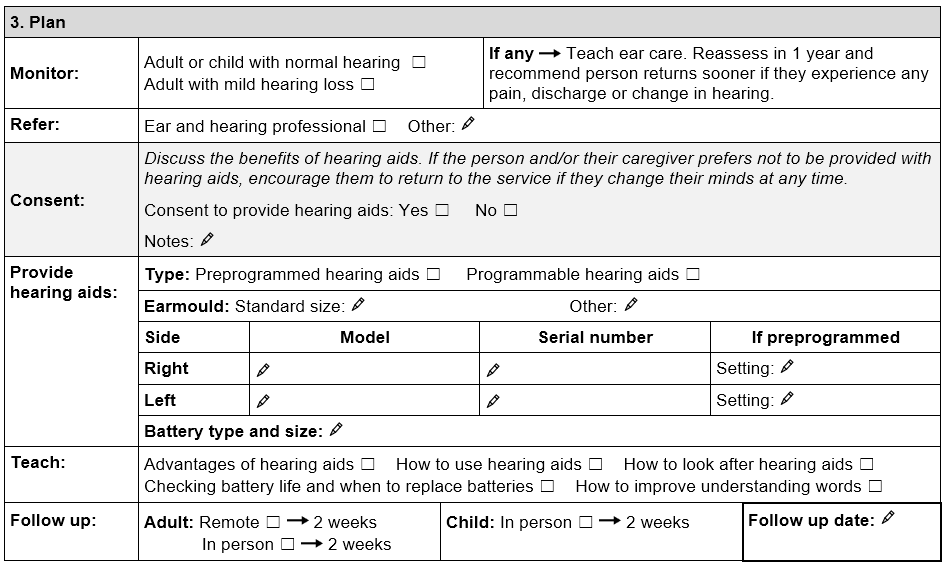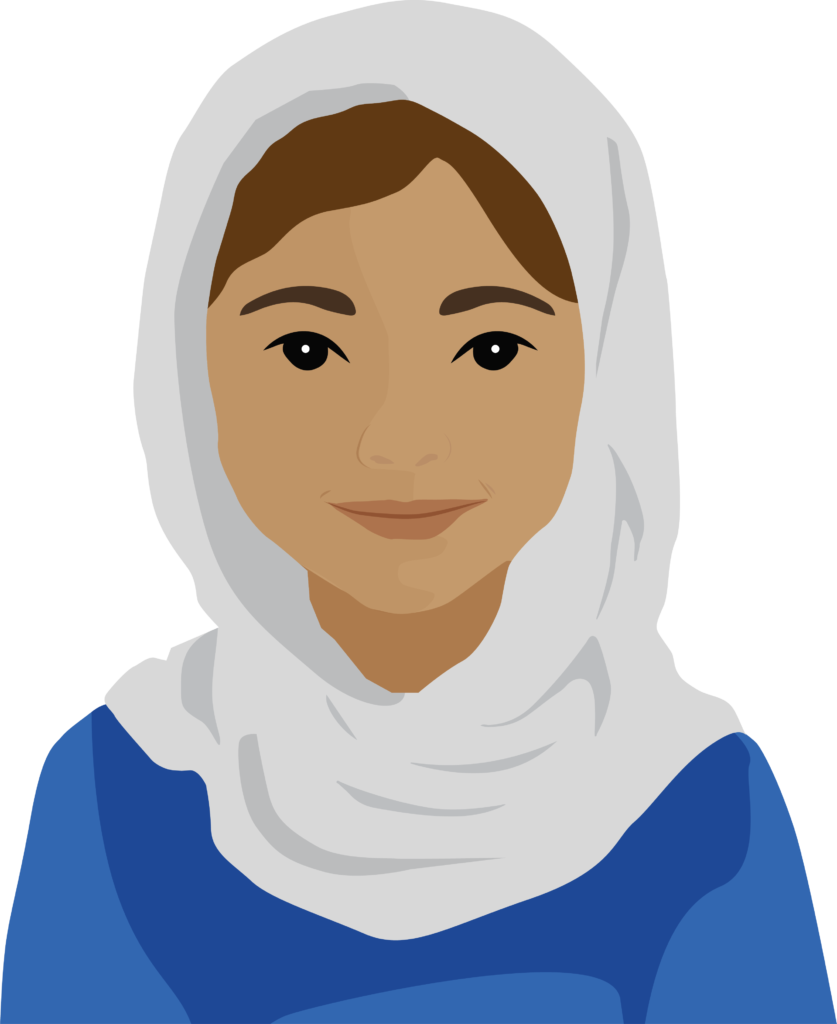ከግምገማው ቃለ መጠይቅ በኋላ ከልጁ እና ከተንከባካቢዎቻቸው ጋር እቅድ ያውጡ። ዕቅዱ የሚከተሉትን ሊያካትት ይችላል-
- ክትትል ችሎት
- ሪፈራል ማድረግ
- የመስሚያ መርጃ መሳሪያዎችን መስጠት
- ህፃኑ እና ተንከባካቢዎቻቸው የመስሚያ መርጃ መሳሪያዎችን ደህንነቱ በተጠበቀ ሁኔታ እንዴት መጠቀም እንደሚችሉ ማስተማር
- የክትትል ቀጠሮ በመያዝ ላይ።

የመስማት ችሎታን ይቆጣጠሩ
በመደበኛ የመስማት ክልል ውስጥ ልጆችን መከታተል እና የመስማት ችሎታን እንደገና ለመሞከር በአንድ አመት ውስጥ ክትትል ማቀድ አለብዎት።
የመስማት ችግር ካለ ህፃኑ እና ተንከባካቢው ቶሎ እንዲመለሱ ያበረታቱ።
አንጁን አስታውስ?

የአንጁ የመስማት ችሎታ ምርመራ ውጤት በሁለቱም ጆሮዎች ውስጥ በተለመደው የመስማት ክልል ውስጥ ነበር።
የጤና ባለሙያው የአንጁን ጆሮ ጤናማ ለማድረግ የሚረዱ አንዳንድ ቀላል ነገሮች እንዳሉ ያብራራሉ፡-
- ማንኛውንም ነገር በጆሮዎ ውስጥ ከማስቀመጥ ይቆጠቡ
- በቆሸሸ ውሃ ውስጥ ከመዋኘት ይቆጠቡ
- ጫጫታ በሚበዛባቸው አካባቢዎች የጆሮ መሰኪያዎችን ይጠቀሙ።
የጤና ሰራተኛው አንጁን እና ወላጆቿን የአንጁን የመስማት ችሎታ ለመቆጣጠር ለተደጋጋሚ የመስማት ችሎታ በአንድ አመት ውስጥ እንዲመለሱ ጠይቃለች። አንጁ የጆሮ ህመም፣ ፈሳሽ ወይም የመስማት ለውጥ ካጋጠመው ቶሎ እንደሚመለስ ያብራራሉ።
ያጣቅሱ
አንዳንድ ልጆች በጆሮ እና የመስማት ችሎታ ባለሙያ የበለጠ ልዩ ባለሙያ ግምገማ ይፈልጋሉ።
ለሚከተሉት የመስሚያ መርጃ መሳሪያዎችን አታቅርቡ፡-
- ከከባድ እስከ ጥልቅ የመስማት ችግር ያለባቸው ልጆች
- ተመጣጣኝ ያልሆነ የመስማት ችግር ያለባቸው ልጆች - በቀኝ እና በግራ ጆሮ መካከል ከ 15 ዲቢቢ በላይ ልዩነት.
ከተንከባካቢ ፈቃድ ጋር የጆሮ እና የመስማት ችሎታን ያማክሩ።
በፈተናው ውጤት እርግጠኛ ካልሆኑ ከአማካሪዎ ጋር ይወያዩ እና የጆሮ እና የመስማት ችሎታን ያማክሩ።
ጥያቄ
የሚከተሉትን የጉዳይ ጥናቶች አንብብ።
1. ቤት 13 ዓመቷ ነው። የቀኝ ጆሮዋ አማካኝ የመስማት ገደብ 67 ዲቢቢ ነው። በግራ ጆሮዋ ውስጥ ያለው አማካኝ የመስማት ገደብ 69 ዲቢቢ ነው።
የመስማት ችግርን ሠንጠረዥ ይመልከቱ.
| የደረጃ ውጤት | አማካኝ | ምክር |
| በጤናማ ክልል ውስጥ | አማካይ ከ 20 ዲባቢ ያነሰ | ጎልማሶች እና ልጆች፡ የመስሚያ መርጃ መሳሪያዎች አያስፈልጉም። የጆሮ እንክብካቤን ያስተምሩ. ሰው ወይም ተንከባካቢ የመስማት ወይም የጆሮ ጤና ለውጥ ካዩ በ1 አመት ወይም ከዚያ ቀደም ብለው ይገምግሙ። |
| ቀላል የመስማት ችግር | አማካይ 20-34 ዲቢቢ | ልጆች: የመስሚያ መርጃ ተስማሚ. አዋቂዎች፡ በ1 አመት ውስጥ ይቆጣጠሩ እና እንደገና ይገምግሙ። የጆሮ እንክብካቤን ያስተምሩ. |
| መካከለኛ የመስማት እክል | አማካይ 35-49 ዲቢቢ | አዋቂዎች እና ልጆች: የመስሚያ መርጃ ተስማሚ. |
| መካከለኛ ከባድ የመስማት ችግር | አማካይ 50-64 ዲቢቢ | አዋቂዎች እና ልጆች: የመስሚያ መርጃ ተስማሚ. |
| ከባድ የመስማት እክል | አማካይ 65-79 ዲቢቢ | ልጆች፡- የጆሮ እና የመስማት ባለሙያን ይመልከቱ። አዋቂዎች፡ የመስሚያ መርጃ መግጠሚያ። |
| ከባድ የመስማት ችግር | አማካይ ከ 80 ዲቢቢ | አዋቂዎች እና ልጆች፡- የጆሮ እና የመስማት ችሎታ ባለሙያን ይመልከቱ |
ቀጥሎ ምን ታደርጋለህ?
አንዱን ይምረጡ።
ሪፈር ትክክል ነው!
ቤዝ ከባድ የመስማት ችግር አለባት። ከተንከባካቢዎቿ ፈቃድ ጋር መሆን አለባት ለበለጠ ልዩ ባለሙያ ግምገማ ወደ ጆሮ እና የመስማት ባለሙያ መላክ.
2. ጃምፓ 11 አመቱ ነው። የቀኝ ጆሮው አማካይ የመስማት ገደብ 23 ዲባቢ ነው. በግራ ጆሮው ውስጥ ያለው አማካይ የመስማት ችሎታ 55 dB ነው.
ቀጥሎ ምን ታደርጋለህ?
አንዱን ይምረጡ።
ሪፈር ትክክል ነው!
ጃምፓ በቀኝ እና በግራ ጆሮው መካከል ከ15 ዲቢቢ በላይ ልዩነት አለው። በእሱ ተንከባካቢዎች ፈቃድ, እሱ መሆን አለበት ለበለጠ ልዩ ባለሙያ ግምገማ ወደ ጆሮ እና የመስማት ባለሙያ መላክ.
ፍቃድ
አንዳንድ ልጆች የመስሚያ መርጃዎችን ይጠቀማሉ።
የመስሚያ መርጃ መሳሪያዎችን ሊያገኙ የሚችሉትን ጥቅሞች ያብራሩ እና ከመወሰንዎ በፊት ህፃኑ የመስሚያ መርጃ መሳሪያዎችን እንዲጠቀም እድል ይስጡት።
ልጁ ወይም ተንከባካቢያቸው የመስሚያ መርጃ መርጃዎች እንዳይሰጡ ከመረጡ፣ በማንኛውም ጊዜ ሃሳባቸውን ከቀየሩ ወደ አገልግሎቱ እንዲመለሱ ያበረታቷቸው።
ህፃኑ እና ተንከባካቢው የመስሚያ መርጃ መሳሪያዎችን ለማቅረብ ስምምነት ከሰጡ ይመዝግቡ።
የመስሚያ መርጃዎችን ያቅርቡ
መጀመሪያ ካሉት አማራጮች ውስጥ በፕሮግራም ሊሰራ የሚችል የመስሚያ መርጃ አይነት ይምረጡ።
በቅጹ ላይ ዝርዝሮችን ይመዝግቡ የሚከተሉትን ጨምሮ፡-
- የመስሚያ አጋዥ
- የጆሮ ቅርጸ አካል(Earmould)
- ባትሪ.
ጠቃሚ ምክር
ለተከታታይ ቁጥሮች ማሸግ እና የተጠቃሚ መመሪያን ያረጋግጡ። የመስሚያ መርጃው ሲገናኝ በፕሮግራሚንግ ሶፍትዌሩ ውስጥ በፕሮግራም ሊሰራ የሚችል የመስሚያ መርጃ ቁጥር ሊመዘገብ ይችላል።
እንዴት እንደሚጠቀሙ አስተምሩ
አንድ ልጅ ከመስሚያ መርጃዎች የበለጠ ጥቅም እንዲያገኝ ለልጁም ሆነ ለተንከባካቢው ማስረዳት አስፈላጊ ነው፡-
- የመስሚያ መርጃዎች ጥቅሞች
- የመስሚያ መርጃዎችን እንዴት እንደሚጠቀሙ እና እንደሚንከባከቡ
- የባትሪ ዕድሜን እንዴት ማረጋገጥ እንደሚቻል እና ባትሪዎችን መቼ እንደሚተኩ
- የቃላትን ግንዛቤ እንዴት ማሻሻል እንደሚቻል።
መመሪያ
የመስሚያ መርጃ መሳሪያዎችን እንዴት መጠቀም እንደሚቻል ትምህርት አራት ላይ የበለጠ ተማር።
ይከታተሉ
ልጆች የመስሚያ መርጃ መሳሪያዎችን ለመጠቀም ጊዜ ያስፈልጋቸዋል። በቀላል ችግር መፍታት ላይ ምክር ሊረዳ ይችላል.
እንዴት እየሆኑ እንደሆነ ለማወቅ በሁለት ሳምንታት ውስጥ ከልጁ እና ከአሳዳጊዎቻቸው ጋር በአካል በመቅረብ መከታተል አስፈላጊ ነው።
መመሪያ
የመስሚያ መርጃ ክትትልን በተመለከተ ትምህርት አምስት ላይ የበለጠ ተማር።
መመሪያ
ለባሲር እቅድ በማውጣት እውቀትዎን ይፈትሹ።
ጥያቄ

ባሲርን አስታውስ?
ባሲር የስድስት ዓመት ልጅ ሲሆን ከአምስት ዓመቷ እህቱ ሲቲ ጋር ወደ ትምህርት ቤት ይሄዳል። ከትምህርት ቤት የማጣሪያ ምርመራ በኋላ ባሲር የመስማት ችሎታ ፈተና ተላከ። ባሲር የመስማት ችግር እንዳለበት ታውቋል. ውጤቶቹ እንደሚያሳዩት ባሲር በቀኝ ጆሮው 53.75 dB እና በግራ ጆሮው 56.25 ዲቢቢ አማካይ የመስማት ደረጃ አለው።
የመስማት ችግርን ሠንጠረዥ ይመልከቱ.
| የደረጃ ውጤት | አማካኝ | ምክር |
| በጤናማ ክልል ውስጥ | አማካይ ከ 20 ዲባቢ ያነሰ | ጎልማሶች እና ልጆች፡ የመስሚያ መርጃ መሳሪያዎች አያስፈልጉም። የጆሮ እንክብካቤን ያስተምሩ. ሰው ወይም ተንከባካቢ የመስማት ወይም የጆሮ ጤና ለውጥ ካዩ በ1 አመት ወይም ከዚያ ቀደም ብለው ይገምግሙ። |
| ቀላል የመስማት ችግር | አማካይ 20-34 ዲቢቢ | ልጆች: የመስሚያ መርጃ ተስማሚ. አዋቂዎች፡ በ1 አመት ውስጥ ይቆጣጠሩ እና እንደገና ይገምግሙ። የጆሮ እንክብካቤን ያስተምሩ. |
| መካከለኛ የመስማት እክል | አማካይ 35-49 ዲቢቢ | አዋቂዎች እና ልጆች: የመስሚያ መርጃ ተስማሚ. |
| መካከለኛ ከባድ የመስማት ችግር | አማካይ 50-64 ዲቢቢ | አዋቂዎች እና ልጆች: የመስሚያ መርጃ ተስማሚ. |
| ከባድ የመስማት እክል | አማካይ 65-79 ዲቢቢ | ልጆች፡- የጆሮ እና የመስማት ባለሙያን ይመልከቱ። አዋቂዎች፡ የመስሚያ መርጃ መግጠሚያ። |
| ከባድ የመስማት ችግር | አማካይ ከ 80 ዲቢቢ | አዋቂዎች እና ልጆች፡- የጆሮ እና የመስማት ችሎታ ባለሙያን ይመልከቱ። |
ለባሲር ምን እርምጃ ትመክራለህ?
አንዱን ይምረጡ።
የመስሚያ መርጃዎችን ያቅርቡ ትክክል ነው!
ባሲር በሁለቱም ጆሮዎች ላይ መጠነኛ ከባድ የመስማት ችግር አለበት። የመስማት ችሎታን መቀጠል ይመከራል።